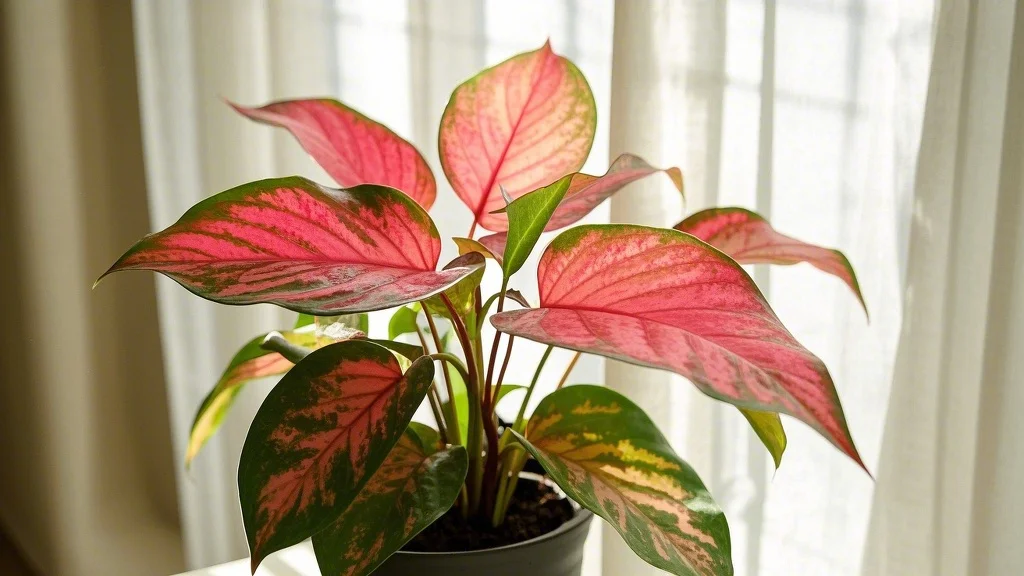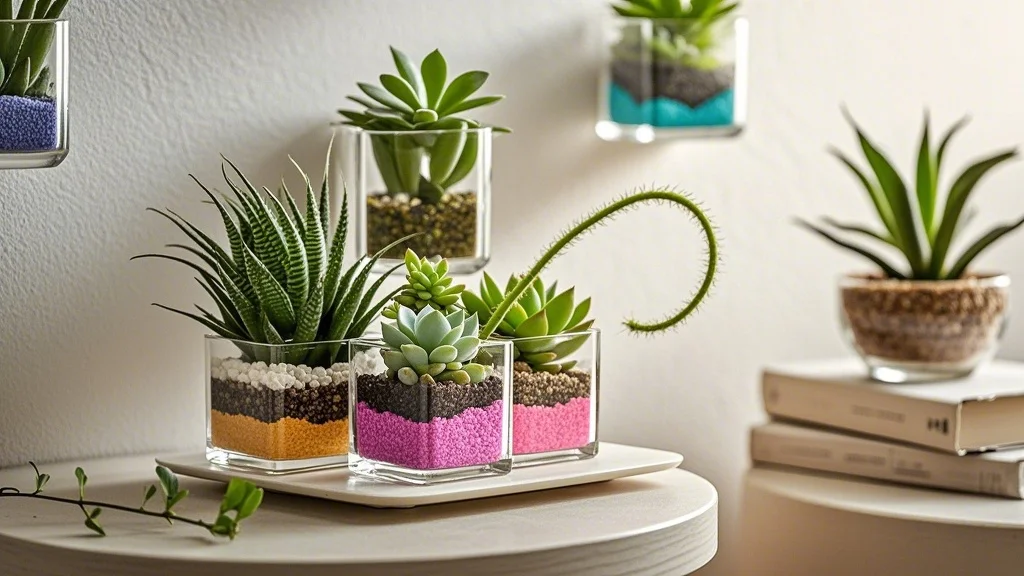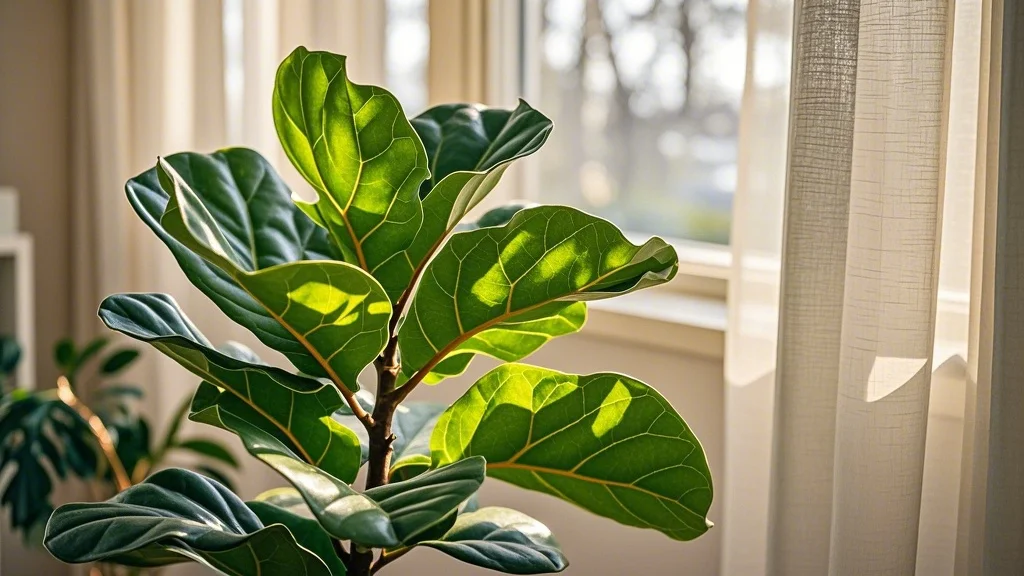Chinese evergreen (Aglaonema) is a popular houseplant known for its striking foliage and easy-care nature. Perfect for beginners and office environments, this versatile plant thrives in low light conditions and adds a touch of tropical elegance to any space.
Difficulty Level: Easy
Contents
Basic Information
- Scientific Name: Aglaonema
- Origin: Tropical and subtropical regions of Asia
- Toxicity: Mildly toxic to pets and humans if ingested
- Height: 1-3 feet (30-90 cm)
- Spread: 1-2 feet (30-60 cm)
- Leaf Color: Various shades of green, silver, pink, and red
Quick Care Guide
- Light: Low to moderate indirect light
- Water: Allow top inch of soil to dry between waterings
- Humidity: Moderate to high (50-60%)
- Temperature: 60-75°F (15-24°C)
- Soil: Well-draining potting mix
- Fertilizer: Monthly during growing season with balanced liquid fertilizer
Detailed Care Instructions

Light Requirements
Chinese evergreens are renowned for their ability to thrive in low light conditions, making them ideal for offices and darker corners of homes. However, they can adapt to a range of light levels:
- Low Light: Aglaonemas can survive in low light areas, but growth may be slower, and variegated varieties might lose some color intensity.
- Moderate Indirect Light: This is the ideal light condition for most Chinese evergreens. Place them near north or east-facing windows for optimal growth and color development.
- Bright Indirect Light: Some varieties, especially those with colorful foliage, can tolerate brighter indirect light. Avoid direct sunlight, as it can scorch the leaves.
To ensure your Chinese evergreen receives appropriate light:
- Observe leaf color: If leaves become pale or lose variegation, the plant may need more light.
- Rotate the plant regularly to promote even growth.
- Use sheer curtains to filter bright light if necessary.
Watering Guide
Proper watering is crucial for Chinese evergreen care. These plants prefer consistently moist soil but are susceptible to root rot if overwatered.
Follow these watering tips:
- Check soil moisture: Insert your finger about an inch into the soil. If it feels dry, it’s time to water.
- Water thoroughly: When watering, do so until water drains from the bottom of the pot.
- Allow drainage: Never let the plant sit in standing water.
- Adjust for seasons: Reduce watering frequency in winter when growth slows.
- Use room temperature water: Cold water can shock the roots.
Signs of improper watering:
- Overwatering: Yellowing leaves, mushy stems, or mold on soil surface
- Underwatering: Drooping leaves, crispy brown edges, or slow growth
Common Problems and Solutions

1. Yellowing Leaves
Cause: Often due to overwatering or poor drainage.
Solution:
- Reduce watering frequency
- Ensure pot has proper drainage holes
- Repot in fresh, well-draining soil if necessary
2. Brown Leaf Tips
Cause: Low humidity or fluoride in tap water.
Solution:
- Increase humidity with a pebble tray or humidifier
- Use distilled or rainwater for watering
- Mist leaves regularly
3. Pest Infestations
Cause: Common pests include mealybugs, spider mites, and scale insects.
Solution:
- Isolate affected plants
- Wipe leaves with neem oil solution
- Use insecticidal soap for severe infestations
- Improve air circulation around the plant
Buying Guide and Essential Supplies
When purchasing a Chinese evergreen:
- Look for plants with vibrant, unblemished leaves
- Check for signs of pests or disease
- Choose a size appropriate for your space
Essential supplies for Chinese evergreen care:
- Well-draining potting mix: Blend regular potting soil with perlite or orchid bark for improved drainage.
- Appropriate pot: Choose a container with drainage holes, 1-2 inches larger than the current pot.
- Watering can: Long-spouted for precise watering.
- Humidity tray: To increase moisture around the plant.
- Pruning shears: For removing dead or yellowing leaves.
- Liquid fertilizer: Balanced, water-soluble formula for monthly feeding.
Frequently Asked Questions (FAQ)
1. Can Chinese evergreens be propagated easily?
Yes, Chinese evergreens can be propagated through stem cuttings or division. For stem cuttings, select a healthy stem with at least two leaves and root it in water or moist soil. For division, separate the plant into smaller sections during repotting, ensuring each section has roots and leaves.
2. How often should I repot my Chinese evergreen?
Chinese evergreens generally need repotting every 2-3 years or when they outgrow their current container. Spring is the best time to repot, using a pot 1-2 inches larger in diameter.
3. Are Chinese evergreens air-purifying plants?
Yes, Chinese evergreens are known for their air-purifying qualities. They can help remove indoor air pollutants such as benzene and formaldehyde, making them excellent choices for improving indoor air quality.
4. Can Chinese evergreens be grown outdoors?
Chinese evergreens are primarily indoor plants but can be grown outdoors in USDA hardiness zones 10-12. They require protection from direct sunlight and temperatures below 55°F (13°C).
5. How do I encourage more colorful foliage in my Chinese evergreen?
To enhance leaf color:
- Provide bright, indirect light
- Maintain consistent humidity
- Feed regularly during the growing season
- Choose varieties known for vibrant foliage, such as ‘Red Siam’ or ‘Silver Bay’
By following these care instructions and tips, you’ll be well-equipped to grow healthy, beautiful Chinese evergreens in your home or office. These resilient plants offer a perfect blend of aesthetic appeal and low-maintenance care, making them an excellent choice for plant enthusiasts of all levels.








